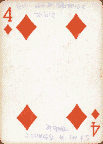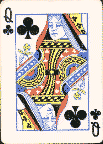A Real Fortune Teller's Deck
![[Ace of Spades]](gramaas2.gif)
![[Back of Cards]](gramabk2.gif) This
is a deck of standard playing cards. A red-back Bicycle 808, it has no
arcane symbolism, it bears no exotic drawings, and it's imbued with no
magical portents or properties. It belongs to a friend, given to her by
her grandmother. The only indications that this was ever used for anything
other than Canasta or Gin are a few quick words written at the top of many
of the cards, like "Money" and "Trouble." Like many tools in the real world,
it's not ornate or fancy, but simple and easy to overlook.
This
is a deck of standard playing cards. A red-back Bicycle 808, it has no
arcane symbolism, it bears no exotic drawings, and it's imbued with no
magical portents or properties. It belongs to a friend, given to her by
her grandmother. The only indications that this was ever used for anything
other than Canasta or Gin are a few quick words written at the top of many
of the cards, like "Money" and "Trouble." Like many tools in the real world,
it's not ornate or fancy, but simple and easy to overlook.
In the suburbs of Boston during the late sixties and early seventies,
my friend sat with her grandmother and learned how to play the old parlor
game. Her grandmother told her that she had learned the game from her own
grandmother in the teens and twenties of this century while sitting in
a window seat of their Dorchester home. The grandmother's grandmother was
born in France, and thus the game may well have been borrowed from the
Gypsies of France in the eighteenth century.
It was a fortune-telling game, where you shuffled, divided and re-divided
the deck, and finally laid out a portion of it for reading. Each card had
some bit of meaning (some referred to circumstances, others to people),
and they took on complete meanings only when they came up in particular
places. The person requesting the reading was asked to make a wish and
keep it to themselves, shuffle and cut the deck a few times, and otherwise
watch the reading and weigh what they learned against what they knew. The
reader didn't know the wish during the reading.
The grandmother didn't believe in it, and I doubt that the granddaughter
does now, since she's the one who calls it just a game. But it's a fun
diversion in the right situations. Like Ouija or even the Magic Eight Ball,
the fun lies in trying to interpret random responses as answers to complex
questions. More often than not, the person making the wish will find new
ways to interpret their wishes or even bring them to fruition, and give
the credit to the fortune-teller. Still, whenever my friend's grandmother
would have someone come back and report that her reading had been uncannily
accurate, out of fear she wouldn't read for them again. As a parlor game,
it's fun. But real divination (or even apparent divination) is chilling.
|
Six of Spades

Trouble
|
Seven of Hearts

Good Hearts
|
|
Four of Diamonds

Sit at a Strange Table
|
Queen of Clubs

A Dark Complected Woman
|
The meanings of the individual cards, without context in a reading,
are fairly vague. There are several diamonds which are all labeled "Money,"
for instance, and they are all essentially indistinguishable. "Trouble"
in the spades is also repeated a few times. Some cards are singular, and
have specific meanings, like the four of diamonds above, or the ace of
diamonds, which signifies "A Letter." And the face cards all refer to people,
with the spades and clubs referring to "dark complected" people, and the
hearts and diamonds referring to the "light complected" ones. Jacks are
young men, kings are older men, and queens are women in general. If you're
curious, click here for a table of all the declared
meanings.
The specific meanings of the cards becomes apparent only through their
juxtaposition with other cards. If you have "Money," "Sit at a Strange
Table," and "Deceit" all in a row, you might infer that you shouldn't go
gambling at a stranger's house any time soon. It falls to the readers themselves
to make the subjective interpretations of the cards. If a card feels out
of place, they can move it to where it fits. They are even free to deduce
just what the words mean, for instance whether "Deceit" above means that
the subject is being deceived or doing the deceiving, or even if they'll
just hear about someone else being deceived.
Perhaps the best way to describe the way to interpret the meanings is
to show the steps to a complete reading. The first step is to have the
querent, the person asking for the reading (a term I learned from Buckland's),
shuffle the deck while considering their wish. Then they cut the deck twice,
making three piles. The bottom segment is pile one, the middle is pile
two, and the top is pile three. The reader turns each pile over in order,
and reads the meaning of the bottom-most card of each aloud. The deck is
then recombined, with pile three now on the bottom, two in the middle,
and one on the top.
The reader then turns up each card one at a time, while mentally counting
down from king to ace as each card is revealed. If a card's number matches
the counting, it is removed and put aside. After counting down to ace,
start again at king, and repeat until you run out of cards. Perform this
entire series, from cutting to counting, three times, but don't reshuffle.
Then take the remaining cards (those not already laid aside) and fan
them out, face down, on the table. Have the querent choose twenty-one of
them without looking at them. The remaining cards can be set aside, as
they won't be used any more. Take the 21 cards and combine them with the
cards set aside during the counting, and have the querent shuffle them
together one last time.
The reader then deals the cards into seven piles, face down, and the
main reading begins. The reader turns over each pile in turn, fanning the
cards like a poker hand, without changing the order. The meanings of the
cards are read left to right like a sentence. If the last card (or cards)
should feel out of place to the reader, it can be moved to the top of the
next pile. The statements embodied in the seven piles comprise the reading.
The specific meanings and importance of each of the seven piles, as
well as each of the cut cards at the beginning, have been lost. The grandmother
didn't remember them when teaching my friend, and no other source now exists
to ask. So she just reads them however it feels best, sometimes as a chronology,
sometimes just as individual situations, with each reading having its own
set of patterns. Likewise, my friend believes that many of the cards which
share the same meaning now, like all the "Money" cards, may once have had
different meanings, and have become the victims of her grandmother's fading
memories.
The similarity of this system with Buckland's
general approach to card-reading is great. There is by no means a perfect
match in any of his systems, but this one feels very compatible with the
greater field of Gypsy cartomancy in general. It bears an even more striking
resemblance to the Minor Arcana of the Tarot, with many cards having exactly
the same meaning. To me, it seems obvious that the system shown here descended
through a family for a few hundred years originally from a system of Tarot
reading, until it became what we have today.
Return to cards page
Send me mail.
![[Ace of Spades]](gramaas2.gif)
![[Back of Cards]](gramabk2.gif) This
is a deck of standard playing cards. A red-back Bicycle 808, it has no
arcane symbolism, it bears no exotic drawings, and it's imbued with no
magical portents or properties. It belongs to a friend, given to her by
her grandmother. The only indications that this was ever used for anything
other than Canasta or Gin are a few quick words written at the top of many
of the cards, like "Money" and "Trouble." Like many tools in the real world,
it's not ornate or fancy, but simple and easy to overlook.
This
is a deck of standard playing cards. A red-back Bicycle 808, it has no
arcane symbolism, it bears no exotic drawings, and it's imbued with no
magical portents or properties. It belongs to a friend, given to her by
her grandmother. The only indications that this was ever used for anything
other than Canasta or Gin are a few quick words written at the top of many
of the cards, like "Money" and "Trouble." Like many tools in the real world,
it's not ornate or fancy, but simple and easy to overlook.



